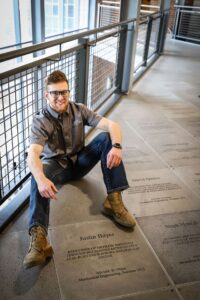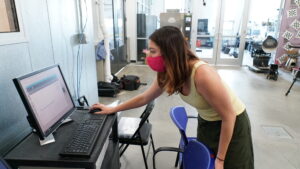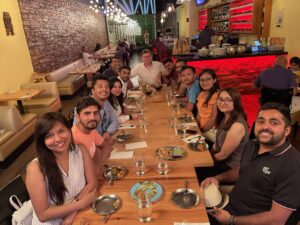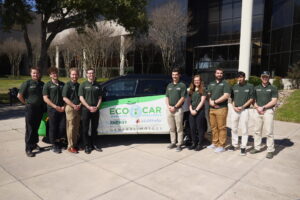
Floor tiles celebrate graduate student contributions to CSU Energy Institute research, entrepreneurship
If the walls of the CSU Powerhouse Energy Campus could talk, they’d certainly have a lot to say. The floor tiles on the second floor, however, tell a story of the hard work and dedication of CSU alum who roamed those hallways.
Engraved floor tiles in the Powerhouse Energy Campus pay tribute to the achievements of CSU Energy Institute graduate students. Tiles display the students’ names, thesis or dissertation titles, graduation years, departments and advisors.

“Graduate students are the brick and mortar of CSU Energy Institute,” said Jason Quinn, operating director of the Energy Institute. “They’re the reason we’re here.”
The spirit of celebration extends to over 175 graduate students who have been advised by institute researchers and made use of the institute facilities at the Powerhouse. As part of the Rapid Prototyping Lab, student Alex Willman started engraving and placing tiles on the second floor of the Powerhouse in Fall 2023 and will continue as students graduate.
Energy Institute alum represent six colleges and 17 departments across CSU, with the greatest number of graduates coming from the Walter Scott Jr. College of Engineering. Often working in partnership with industry and/or environmental advocates, graduate students have led projects around such topics as environmental carbon sequestration, cookstove impacts on health, electric vehicles, and engine efficiency.
Read a sampling of Energy Institute alum and where they are now.
Morgan DeFoort, Mechanical Engineering Ph.D., 2008

DeFoort completed a doctorate in Mechanical Engineering in 2008 advised by Professor Azer Yalin. From 2013 to 2015, DeFoort was a co-director of the Energy Institute. During his time at CSU, DeFoort supported university cleantech spinouts during formation and launch through CSU STRATA. DeFoort says while conducting energy research, he recognized the immense potential of unrealized technology and innovation in increasing global energy access.
Bryan Willson, executive director of the CSU Energy Institute, co-founded Factor[e] Ventures with DeFoort in 2013 with support from the Shell Foundation. Factor[e] is an innovation factory that enables breakthrough technologies to address the most pressing climate and development challenges in emerging markets. Factor[e]’s portfolio includes companies that work across the energy, agriculture, mobility, and water sectors.
“Technology and innovation can help us tackle tough problems, create opportunities for sustainable growth, and improve resiliency in the face of climate change in the Global South,” said DeFoort, “At Factor[e], we invest in solutions that solve important social problems through creative thinking and bold ideas.”
Over the years, Factor[e] has made strategic investments in 30 companies across 44 countries, primarily focused on critical sectors such as agriculture, energy, mobility, and water. These investments have translated into the creation of 1,425 full-time jobs, sustainable improvements in the lives of over 53 million people, and a reduction of 3.4 million metric tons of greenhouse gas emissions.
DeFoort’s dissertation, Laser Ignition for Internal Combustion Engines via Fiber Optic Delivery, was about reducing emissions and improving engine efficiency. In contrast to traditional spark plugs, DeFoort worked on laser ignition through a combination of modeling and experiments. This work represents the first demonstration of fiber-optically delivered laser ignition on an engine.
DeFoort’s experimental work on engines was conducted in the historical part of the Powerhouse Energy Campus, called the Engines and Energy Conversion Lab. With infrastructure for conducting experiments using real engines, researchers put their theories developed through models to the test in a controlled, safe environment.
Kristen Good, Epidemiology Ph.D., 2018

Good credits her undergraduate in Biology and Master’s degree in Environmental Management from Duke University for building her foundational interest in interdisciplinary research. This background set the stage for addressing One Health topics around the cyclical balance among people, the environment, and public health.
Conducting her doctoral work at CSU through the department of Environmental and Radiological Health Sciences, Good’s dissertation work addressed pollution impacts of open-flame cookstoves. This household air pollution, primarily carbon monoxide, is responsible for four million deaths a year. Open flame cookstoves are commonly used in Mexico, India, Nigeria, South Africa, and other countries around the world.
“Imagine if you were to wake up every morning and rather than turning on your toaster oven to stick your Eggo waffle in, you have to sit there in your kitchen or in your home and start a campfire,” said Good. “That’s what a lot of people around the world do, and the results of that is the generation of a lot of air pollution that then is trapped in that indoor space.”
Good’s dissertation work prepared her for the COVID research and response work she conducted next.
“I was really well trained to think about not just the public health side of things, but the exposure side as well,” said Good. “How does exposure to contaminants in the air happen? How do different contaminants move through the air?”
In 2020, Good conducted research at the Powerhouse as a postdoctoral scholar in Mechanical Engineering Professor John Volckens’ lab on bioaerosols produced from playing instruments or singing. These performances generate small-sized droplets and particles that could be carrying a pathogen like COVID.
At the same time, Good started her current position working as an epidemiologist for the Colorado Department of Public Health and Environment. Good now serves as the Health Equity Branch Deputy Chief, having recently celebrated four years of working at the CDPHE.
Good suggests that early career researchers find the balance between what they’re passionate about and what needs are out there.
“One of the biggest struggles that I see, others who are kind of coming up in their career behind me here is that they might be really passionate about certain things but there’s no jobs in that area. How do you turn that passion into what you want to do, or where you might go?” said Good, “There’s a lot of great people around the Energy Institute – a lot of great classes offered – that can help you kind of test out some of those different skills and think about: what am I going to enjoy doing every day?”
Good’s dissertation is titled Cookstove Startup Material Characterization and Quantification and Acute Cardiopulmonary Effects from Controlled Exposure to Cookstove Air Pollution.
Oluwatobi Oke, Civil and Environmental Engineering Ph.D., 2022

Oluwatobi “Tobi” Oke may have the gift of perfect timing. In 2016, after completing his master’s degree at the New Mexico Institute of Mining and Technology, he sought a doctoral program where he could research indoor air quality and exposure to air pollutants. As luck would have it, Ellison Carter, associate professor of Civil and Environmental Engineering, was launching the indoor air quality and exposure science research group at CSU. Oke became the first student in Carter’s lab, housed at the Energy Institute.
“I am incredibly fortunate to have been able to work with Tobi as my first PhD student,” said Carter. “He is incredibly hard-working, diligent, thoughtful, and persevering. He also has a great enthusiasm, sincerity, and team spirit. He assisted in advancing several projects in the course of completing his dissertation, and he was flexible as that dissertation took shape over time. During his time at CSU, I think we both matured and grew as people in our own ways, and I’m grateful to have been a part of his life and learned from him.”
Oke, originally from Lagos, Nigeria, now works at the National Institute of Standards and Technology (NIST) in Gaithersburg, Maryland as a research associate in the Indoor Air Quality and Ventilation Group of the Engineering Laboratory.
“My research uses human energy expenditure, body composition, and metabolism to investigate the uncertainties associated with human carbon dioxide generation rates to support building ventilation metrics,” said Oke.
He first became aware of the impact of various industrial chemical processes on human health as an undergraduate student. He witnessed the residents of an oil-rich community in Nigeria protest against the construction of a nearby oil rig. He earned bachelor’s and master’s degrees in chemical engineering, focusing on the environmental impact of industrial processes.
The Civil and Environmental Engineering Ph.D. program provided Oke with the analytical and problem-solving skills required to be a productive researcher. Yet, he credits his education at CSU with more than just his technical prowess.
“I also acquired project management skills, communication skills, the ability to approach a challenge from a cross-disciplinary lens, and the ability to manage expectations with team members,” said Oke. “These skills significantly add to my day-to-day work and success at NIST.”
Oke is grateful to Carter for exposing him to a variety of projects across different teams, allowing him to have diverse experiences that have been invaluable to his career today.
His dissertation, Systems-Based Approaches for Evaluating Residential-Based Hazards to Inform Environmental Exposure Intervention Design, investigates the source of three contaminants residents are most often exposed to in their homes; flooding, lead, and chemical mixtures.
Laurie McHale, Mechanical Engineering Ph.D., 2018
Laura “Laurie” McHale can clearly recall the first time she stepped foot on the CSU Fort Collins Campus.
“It was a lovely March Colorado day with big open skies, and the beautiful sun. I remember calling my dad before my flight back home to Michigan and telling him I wanted to go to CSU.”
McHale went on to get her master’s in Atmospheric Science in 2009, and her Ph.D. in Mechanical Engineering (‘18). During her Ph.D., McHale worked in Professor Azer Yalin’s Center for Laser Sensing and Diagnostics Laboratory.
McHale’s research addressed methane leak detection. Methane is a stronger greenhouse gas than carbon dioxide. When released directly into the atmosphere, methane is more harmful than after it has been combusted. She created a small, lightweight analyzer that could be strapped to a car or drone to detect leaks in places like oil fields.
During her first year of her Ph.D., the Powerhouse had finished construction, and the Center for Laser Sensing and Diagnostics Laboratory moved into the new space.
“Moving the lab into the Powerhouse actually led to some of the research I did with Azer on open path optical sensors because our lasers didn’t work when we first got there,” she said. “We eventually figured out there was so much construction dust in the air, it was blockings our laser beams. We realized this is a big problem when working with lasers outside a lab space, too, so we had to come up with solutions.”
McHale now works in California on technology similar to what she developed during her time at the Energy Institute. As someone who started in atmospheric science and transitioned to engineering, she cautions students to not get lost in the weeds when it comes to graduate research.
“I struggled after my master’s degree because I thought I had to love the project I was doing at that time, and that it had to be my life’s purpose, but I realized that you’re not going to enjoy every project, and that’s okay. The important part of graduate work is learning how to learn. You don’t know where life is going to take you, and it’s the skills you learn and the ability to learn new things that’s important.”
Her dissertation was titled Development of Mobile Open-path Cavity Ring-down Spectrometer for Measurement of Trace Atmospheric Methane Gas.
Tim Hansen, Electrical Engineering Ph.D., 2015

Tim Hansen always knew he was going to be an engineer.
“When I was young, my grandpa gave me a toolbox because I kept stealing his tools to take things apart,” said Hansen, whose dad was also an engineer.
Over time, Hansen’s curiosity evolved into a passion for research that uses technology to help people and the environment.
Hansen is now the Harold C. Hohbach Endowed Associate Professor of Electrical Engineering and Computer Science at South Dakota State University. His graduate studies at CSU laid the foundation for his ongoing work to develop “smarter,” more efficient, and reliable electric power systems.
At Colorado State, Hansen explored holistic, data-driven solutions to large-scale energy problems with co-advisers H.J. Siegel and Tony Maciejewski, professors in the Department of Electrical and Computer Engineering (ECE). He also conducted research at the Energy Institute alongside former ECE Professor Sid Suryanarayanan, an expert in smart grid systems.
“I had really good mentors, and I appreciated the supportive and collaborative culture at CSU,” said Hansen. “I still talk to Tony, H.J., and Sid when I need advice … we still write proposals together.”
Beyond academics, Hansen has fond memories of his time at CSU. “It was a great place to go to grad school, and Fort Collins was a fun town,” he said. Hansen remembers being taken aback the first time he took in the view of campus and the foothills from the third floor of the Computer Science building.
Since joining South Dakota State in 2015, Hansen has garnered significant funding and recognition for excellence in teaching and research. His current research builds on his Ph.D. dissertation. He is developing novel models to intelligently integrate renewable energy into the power grid with the goal of carbon neutrality.
In 2019, Hansen received the Holmes MacDonald Outstanding Teaching Award from IEEE-Eta Kappa Nu.
His dissertation was titled: Resource allocation optimization in the smart grid and high-performance computing.
Samantha White, Systems Engineering, M.S., 2022

Samantha White has made her career in building electric vehicle (EV) charging systems. Her main work is to ensure that the computer systems in converted EVs are integrated successfully and that the vehicles can communicate with charging stations.
“Code I wrote has gone more than 5 million miles on EVs I helped to build,” she said. “It’s so cool to know that, and I’m happy to be making a difference.”
White said her interest in engineering started with her parents and especially her mom, an electrical engineer.
“I didn’t know there was a gender gap in engineering until my mom and I started touring colleges and she asked what the gender ratio was,” White said. “It was eye-opening.”
Upon learning she was chosen for a tile, White requested that her full name be spelled out.
“People call me Sam, but I wanted those who saw the tile to know a woman had worked there and succeeded,” she said. “That’s why I had them use my full first name, Samantha.”
White gained her undergraduate degree in mechanical engineering from CSU in 2020 with her senior project focusing on the construction of a vehicle for The EcoCAR Mobility Challenge. Tom Bradley, the Woodward Professor of Systems Engineering and department chair, oversaw CSU’s EcoCAR team, so when White was accepted to a master’s program, she asked him to serve as her advisor. Within Bradley’s research group, she gained experience by converting a Toyota Tacoma into an electric hybrid, eventually securing her first career job through this work.
“It’s important to have an advisor who will give you guidance but not hover over your shoulder too much,” White said. “Also, someone who will give you opportunities to network and to be on papers for publication.”
Her master’s thesis, Physical Validation of Predictive Acceleration Control on a Parallel Hybrid Electric Vehicle, was about improving the acceleration efficiency of a hybrid EV.